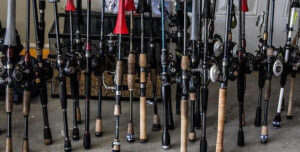You climb into your boat and start pulling your rods out of the rod locker for a full day of fishing. Before you know it you’ve got 10 rods on your deck and several that don’t have the baits you want to throw today. You start cutting the baits off and digging new baits out of the box. Wait. What pound line is on this combo. Where’s my 20-pound line and rod for flipping? Shoot. Which one did I put that 10-pound monofilament line on just for jerkbait fishing? Before we know it, you’ve slept a time or two and have forgotten what line is on which combination.
You start making wild guesses about which rod has the right line, or how old that line is or if that’s actually fluoro or monofilament. It can be frustrating to break off a fish and then realize you’re not throwing the bait on the combo you thought it was.
I’ve been at the avid (aka obsessive-compulsive) bass-fishing lifestyle for about 20 years now. In that time, as you might imagine, I’ve amassed a lot of tackle, including rods and reels. Keeping up with how much the line deteoriates on 25 combos and what pound test and type of line surpassed the limits of my brain capacity years ago. About two trips to the water and I’ve developed full-on amnesia in regards to my line and rod and reel combos. That’s not a good deal for several reasons.
First, if you do have problems with a certain line type, brand or pound test, you might want to know all the rods that have that line on it and get it off there immediately. Fishing line goes bad. It’s a fact. So keeping up with it is really imperative.
Second, because fishing line goes bad, anglers need to know how long line has been on a reel. Chances are if you’re not a touring professional angler, you might leave your fishing line on your reel for more than a day, sometimes more than a month. So keeping up with how old the line is becomes more important.
Finally, with varying diameters from differing brands of line, it’s hard to just grab fishing line and know if it’s 12 pound Trilene XT monofilament or 16 pound Sunline Sniper FC fluorocarbon. So keeping up with the line on each reel helps alleviate mishaps and gives you confidence your bait is being tied to the right line for the job.
There are lots of ways to keep up with fishing line once it’s spooled on a reel. Anglers can choose manufactured tags you can add to Rod Gloves that tell you the technique for that rod, and that can clue anglers as to the pound test and type line probably on the reel. There are tags you can stick on the rods or the reels to tell you pound test and technique at a glance in a full rod locker. There are new rod bands from Sunline that can tell you what pound test is on that rod.
These are all helpful, but you still will have to keep up with when you put line on your reel.
The best solution I’ve found is to just make a spreadsheet. I’ve been using one and throwing a copy in my boat’s rod locker in case I get confused about what is on which rod.
Basically, log everything from which reel to put on which rod, the gear ratio of the reels, the length and action of the rods, the size, type, brand and date spooled for each line and at times even the techniques intend for each rod, although that can change throughout the year as seasons and tendencies change.
It takes a bit to make the first time but once you have it made you can fill it in and keep up with it. I just print off a sheet without the lines filled in and then take it out in the shop and fill in the blanks as I get my combos ready for fishing.
I will sometimes go back in and type all the information in and keep it in my rod locker so at quick glance, I know exactly what rod has what line on it and can go from there as I start changing baits on a trip or span of trips.













